From the Open-Publishing Calendar
From the Open-Publishing Newswire
Indybay Feature
Eye Witness from the Hurricane
This is a report from an ANSWER delegation that just returned from the devastation in New Orleans with photos by Bill Hackwell

Below is a preliminary report from a delegation that went to Louisiana to assess the impact of the hurricane. We just got back. I have also attached a few of my photos. We talked with and videoed scores of people, some still trying to hold on in New Orleans and many others who are displaced. The stories we collected were remarkable in that everyone we talked to had either lost someone in the waters or now could not locate their families. There is no centralization of this information. Normal people talking about saving people in their community was common. Heroic stories after heroic stories. The report below does not mention the time we spent in the astrodome in Houston that has around 12,000 people in it with another 15,000 across the street in the Reliant Center. Time and again people told us how the water just rose so fast there was little they could do. Four young men in their 20's stole a small boat and in thirty hours rescued over 275 people in their neighborhood. As we left New Orleans convoy after convoy of national guard and regular soldiers from the 82nd airborne were pouring in really too late for any significant rescue operation but not too late for the massive recovery of bodies that is about to begin. There is now a mandatory evacuation in New Orleans for the 10,000 people left, they too will be displaced along with the other million and a half people. I'm sure you have seen the outpouring of concern and support from all over the world and it is our estimation that since leaving New Orleans they are being treated well now with medical attention, food, clothing etc. This is all of course on an emergency footing and the big question has to be what is going to become of them after the media trucks have left. As for the government response to this entire disaster it can only be described as one of criminal neglect. Given this new crime against humanity now more than ever we need to protest against the war and occupation in Iraq and the war and occupation here at home on September 24, 11 am, Dolores Park in San Francisco
============
On Saturday September 3, award-winning filmmaker Gloria La Riva,
internationally-acclaimed photographer Bill Hackwell and A.N.S.W.E.R.
Youth & Student Coordinator Caneisha Mills arrived in New Orleans as
an A.N.S.W.E.R. delegation to document an accurate account of the
situation and provide solidarity and support to those in need
The following is an eyewitness report of the crisis in the area
written on Sunday, September 4.
Media reports on September 2 describe anarchy and general chaos as
the climate in all of New Orleans. The national media reports that
hope, supplies and food were now being distributed in the area.
However, once we arrived in the Algiers district of New Orleans after
seven checkpoints, the reality shows otherwise.
Algiers
While 80 percent of New Orleans was submerged in water, Algiers is
one of the few districts that has been spared as it sits higher than
most of the city. An historic district established in 1719, Algiers
is on the west bank of the Mississippi river, across from the French
Quarter. Probably 15% of the residents still remain behind, most of
them determined to stay in their homes. The majority of homes are
still intact, although many have suffered damage. While their houses
survived, the peoples' chance of survival seemed very bleak since
there was no electricity or disbursement of food, water or other
supplies.
"Imagine being in a city, poor, without any money and all of a sudden
you are told to leave and you don't even have a bicycle," stated
Malik Rahim, a community activist in the Algiers section of New
Orleans. "90% of the people don't even have cars."
One woman told us it was not possible for her to evacuate. She said,
"I can't leave. I don't have a car and I have nine children." She and
her husband are getting by with the help of several men in the
community who are joining resources to provide for their neighbors.
The government claims that people can get water, but residents have
to travel at least 17 miles to the nearest water and ice distribution
center. Only one case of water is available per family. Countless
people have no way to drive.
There is a huge military and police presence but none of it to
provide services. All of them, north and south of the river, are
stationed in front of private buildings and abandoned stores,
protecting private property.
The goods they are driving in are for their own forces.
Not one of them has delivered water to Algiers or gone to the houses
to see if sick or elderly people need help. There is no door-to-door
survey to see who was injured. The overwhelming majority of people
who have stayed in Algiers are Black but some are white. One white
man in his late 50s in Algiers pointed across the street to a 10-acre
grassy lot. It looks like a beautiful park. He said, "I had my
daughter call FEMA. I told them I want to donate this land to the
people in need. They could set up 100 tractor trailers with aid, they
could set up tents. No one has ever called me back." He is clearly
angry.
Although some of the residents do express fear of burglaries into
houses, acts of heroism, sacrifice and solidarity are evident
everywhere.
Steve, a white man in his 40s, knocks on Malik's front door. He tells
us, "Malik has kept this neighborhood together. We don't know what
we'd do without his help." He has come in because he needs to use the
phone. Malik's street is the only one with phones still working.
Malik and three of his friends have been delivering food, water and
ice to those in need three times a day, searching everywhere for
goods.
There is a strong suspicion among the residents that this is a
deliberately forced removal. Algiers is full of quaint, historic
French-style houses, with a high real estate value, and signs of
gentrification are evident.
Downtown New Orleans
Although entry is prohibited into downtown New Orleans north and east
of the Mississippi, because of extensive flooding and the almost
total evacuation, we were able to get in on Sunday.
The Superdome is still surrounded by water and all types of military
- helicopters, army trucks, etc - are coming in and out of the area;
however, most of the people have already left. On US-90, the only
road out of New Orleans, convoys of National Guard troops are pouring
into the city, too late for many. According to an emergency issue of
The Times-Picayune, 16,000 National Guard troops now occupy the city.
Water is premium and not available. One African American couple
approached our car. The woman asked us, "Do you have water you could
give us? We have four kids. When they told us to leave before the
hurricane we couldn't. We have no car and no money."
Undoubtedly it is similar in the other states that got the direct hit
of Katrina, Mississippi and Alabama. On the radio we hear reports of
completely demolished towns. What differentiates the rest of the Gulf
coast from New Orleans is that the many thousands of deaths in New
Orleans were absolutely preventable and occurred after the hurricane.
On everyone's lips is the cutting in federal funds to strengthen the
levees of Lake Pontchartrain.
Two reporters from New York tell us they just came from the New
Orleans airport emergency hospital that was set up.
New Orleans International Airport
The New Orleans International Airport was converted into an emergency
hospital center. Thousands of people were evacuated there to get
supplies and food, and for transportation that would take them out of
the city. Many people arrived with only one or two bags, their entire
lives minimized to a few belongings.
Some people did not want to leave their homes, but say they were
forced to do so. For example, one white woman and her husband,
Pauline Noble and Jerome Hill, were forced to evacuate. Pauline said,
"The military told us that we had one minute to evacuate. We said
that we weren't ready and he said they can't force us to leave but if
we don't leave anybody left would be arrested . but it was the end of
the month. The two of us have been living for a couple of months on
$600 a month and rent is $550. At the end of the month, we only had
$20 and 1/8 of a tank of gas. There was no way we could leave."
When it became apparent that nobody was coming back to pick them up,
the couple walked five miles to the airport to see if they could get
help.
Disaster Medical Assistance Teams, doctors, nurses and community
organizations came from as far as San Diego, California and Kentucky
to provide support during the crisis. None of them were dispersed
into the community. When we arrived at the airport on Sunday,
September 4, there were approximately 20 medical people for every one
patient while people in regions such as Algiers and the 9th ward were
left to fend for themselves.
The majority of people in New Orleans blame the local and national
government for the catastrophe. One young Black man said, "The
government abandoned us . [it's] pre-meditated murder." Another said,
"Why would you [the government] protect a building . instead of
rescuing people that have been without food or water for three or
four days? It seems like that was the plan. . We couldn't starve them
out, the hurricane didn't kill them, it seems planned."
Baton Rouge
As we drive to Baton Rouge tonight to visit evacuated people, we hear
on local radio that possibly 10,000 people have died in the flooded
areas of New Orleans. Tonight in one announcement, we hear the names
of some of the missing people still being searched for, a 90-year-old
woman named Lisa, a man 102 years old, two women 82 and 85 years old.
The elderly, the most vulnerable, left to their own devices.
Bodies are lying everywhere, and hidden in attics and apartments. The
announcer describes how one body, rotting after days in the sun, was
surrounded by a wall fashioned from fallen bricks by survivors, and
given a provisional burial to give her some dignity. The sign placed
next to her body said, "Here lies Vera, God Help Us."
At a Red Cross shelter outside of Baton Rouge, we meet Emmanuel, who
can't find his wife and three sons after the floods. His story is
shocking. His home is near the 17th Street Canal, where the
Pontchartrain levee broke through.
"I stayed behind to rescue my neighbors while I sent my wife and kids
to dry land," he says. It is difficult for him to relate what
happened. He had a small boat so he went from house to house picking
up neighbors. While doing so, he encountered many bodies in the
water.
"My best friend's body was floating by in the water. One mother whose
baby drowned tied her baby to a fence so she could bury him after she
returned." Because troops kept driving by him and others without
helping them, he had to walk 30 miles north until he was picked up.
This crisis is a crime of the highest magnitude. The Bush
Administration is always able to find money to fund wars that will
benefit the rich of this country; however, when it comes to providing
aid to respond to a disaster of this magnitude, funds, supplies and
resources are lacking. From Bush on down, they should be indicted.
============
On Saturday September 3, award-winning filmmaker Gloria La Riva,
internationally-acclaimed photographer Bill Hackwell and A.N.S.W.E.R.
Youth & Student Coordinator Caneisha Mills arrived in New Orleans as
an A.N.S.W.E.R. delegation to document an accurate account of the
situation and provide solidarity and support to those in need
The following is an eyewitness report of the crisis in the area
written on Sunday, September 4.
Media reports on September 2 describe anarchy and general chaos as
the climate in all of New Orleans. The national media reports that
hope, supplies and food were now being distributed in the area.
However, once we arrived in the Algiers district of New Orleans after
seven checkpoints, the reality shows otherwise.
Algiers
While 80 percent of New Orleans was submerged in water, Algiers is
one of the few districts that has been spared as it sits higher than
most of the city. An historic district established in 1719, Algiers
is on the west bank of the Mississippi river, across from the French
Quarter. Probably 15% of the residents still remain behind, most of
them determined to stay in their homes. The majority of homes are
still intact, although many have suffered damage. While their houses
survived, the peoples' chance of survival seemed very bleak since
there was no electricity or disbursement of food, water or other
supplies.
"Imagine being in a city, poor, without any money and all of a sudden
you are told to leave and you don't even have a bicycle," stated
Malik Rahim, a community activist in the Algiers section of New
Orleans. "90% of the people don't even have cars."
One woman told us it was not possible for her to evacuate. She said,
"I can't leave. I don't have a car and I have nine children." She and
her husband are getting by with the help of several men in the
community who are joining resources to provide for their neighbors.
The government claims that people can get water, but residents have
to travel at least 17 miles to the nearest water and ice distribution
center. Only one case of water is available per family. Countless
people have no way to drive.
There is a huge military and police presence but none of it to
provide services. All of them, north and south of the river, are
stationed in front of private buildings and abandoned stores,
protecting private property.
The goods they are driving in are for their own forces.
Not one of them has delivered water to Algiers or gone to the houses
to see if sick or elderly people need help. There is no door-to-door
survey to see who was injured. The overwhelming majority of people
who have stayed in Algiers are Black but some are white. One white
man in his late 50s in Algiers pointed across the street to a 10-acre
grassy lot. It looks like a beautiful park. He said, "I had my
daughter call FEMA. I told them I want to donate this land to the
people in need. They could set up 100 tractor trailers with aid, they
could set up tents. No one has ever called me back." He is clearly
angry.
Although some of the residents do express fear of burglaries into
houses, acts of heroism, sacrifice and solidarity are evident
everywhere.
Steve, a white man in his 40s, knocks on Malik's front door. He tells
us, "Malik has kept this neighborhood together. We don't know what
we'd do without his help." He has come in because he needs to use the
phone. Malik's street is the only one with phones still working.
Malik and three of his friends have been delivering food, water and
ice to those in need three times a day, searching everywhere for
goods.
There is a strong suspicion among the residents that this is a
deliberately forced removal. Algiers is full of quaint, historic
French-style houses, with a high real estate value, and signs of
gentrification are evident.
Downtown New Orleans
Although entry is prohibited into downtown New Orleans north and east
of the Mississippi, because of extensive flooding and the almost
total evacuation, we were able to get in on Sunday.
The Superdome is still surrounded by water and all types of military
- helicopters, army trucks, etc - are coming in and out of the area;
however, most of the people have already left. On US-90, the only
road out of New Orleans, convoys of National Guard troops are pouring
into the city, too late for many. According to an emergency issue of
The Times-Picayune, 16,000 National Guard troops now occupy the city.
Water is premium and not available. One African American couple
approached our car. The woman asked us, "Do you have water you could
give us? We have four kids. When they told us to leave before the
hurricane we couldn't. We have no car and no money."
Undoubtedly it is similar in the other states that got the direct hit
of Katrina, Mississippi and Alabama. On the radio we hear reports of
completely demolished towns. What differentiates the rest of the Gulf
coast from New Orleans is that the many thousands of deaths in New
Orleans were absolutely preventable and occurred after the hurricane.
On everyone's lips is the cutting in federal funds to strengthen the
levees of Lake Pontchartrain.
Two reporters from New York tell us they just came from the New
Orleans airport emergency hospital that was set up.
New Orleans International Airport
The New Orleans International Airport was converted into an emergency
hospital center. Thousands of people were evacuated there to get
supplies and food, and for transportation that would take them out of
the city. Many people arrived with only one or two bags, their entire
lives minimized to a few belongings.
Some people did not want to leave their homes, but say they were
forced to do so. For example, one white woman and her husband,
Pauline Noble and Jerome Hill, were forced to evacuate. Pauline said,
"The military told us that we had one minute to evacuate. We said
that we weren't ready and he said they can't force us to leave but if
we don't leave anybody left would be arrested . but it was the end of
the month. The two of us have been living for a couple of months on
$600 a month and rent is $550. At the end of the month, we only had
$20 and 1/8 of a tank of gas. There was no way we could leave."
When it became apparent that nobody was coming back to pick them up,
the couple walked five miles to the airport to see if they could get
help.
Disaster Medical Assistance Teams, doctors, nurses and community
organizations came from as far as San Diego, California and Kentucky
to provide support during the crisis. None of them were dispersed
into the community. When we arrived at the airport on Sunday,
September 4, there were approximately 20 medical people for every one
patient while people in regions such as Algiers and the 9th ward were
left to fend for themselves.
The majority of people in New Orleans blame the local and national
government for the catastrophe. One young Black man said, "The
government abandoned us . [it's] pre-meditated murder." Another said,
"Why would you [the government] protect a building . instead of
rescuing people that have been without food or water for three or
four days? It seems like that was the plan. . We couldn't starve them
out, the hurricane didn't kill them, it seems planned."
Baton Rouge
As we drive to Baton Rouge tonight to visit evacuated people, we hear
on local radio that possibly 10,000 people have died in the flooded
areas of New Orleans. Tonight in one announcement, we hear the names
of some of the missing people still being searched for, a 90-year-old
woman named Lisa, a man 102 years old, two women 82 and 85 years old.
The elderly, the most vulnerable, left to their own devices.
Bodies are lying everywhere, and hidden in attics and apartments. The
announcer describes how one body, rotting after days in the sun, was
surrounded by a wall fashioned from fallen bricks by survivors, and
given a provisional burial to give her some dignity. The sign placed
next to her body said, "Here lies Vera, God Help Us."
At a Red Cross shelter outside of Baton Rouge, we meet Emmanuel, who
can't find his wife and three sons after the floods. His story is
shocking. His home is near the 17th Street Canal, where the
Pontchartrain levee broke through.
"I stayed behind to rescue my neighbors while I sent my wife and kids
to dry land," he says. It is difficult for him to relate what
happened. He had a small boat so he went from house to house picking
up neighbors. While doing so, he encountered many bodies in the
water.
"My best friend's body was floating by in the water. One mother whose
baby drowned tied her baby to a fence so she could bury him after she
returned." Because troops kept driving by him and others without
helping them, he had to walk 30 miles north until he was picked up.
This crisis is a crime of the highest magnitude. The Bush
Administration is always able to find money to fund wars that will
benefit the rich of this country; however, when it comes to providing
aid to respond to a disaster of this magnitude, funds, supplies and
resources are lacking. From Bush on down, they should be indicted.
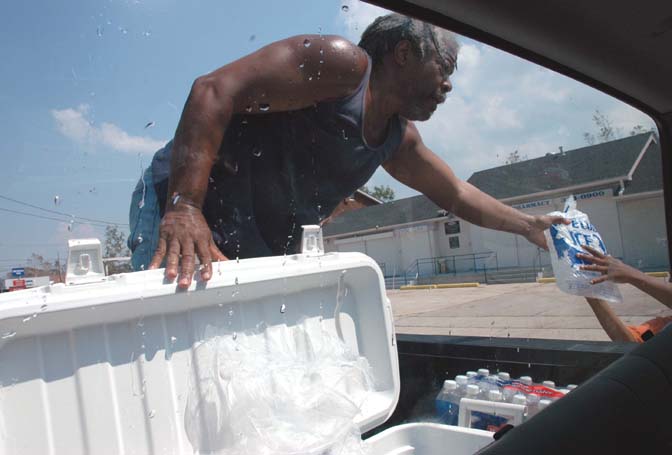
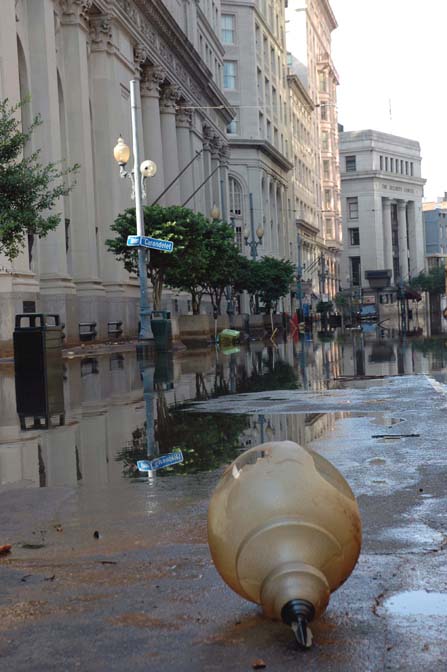
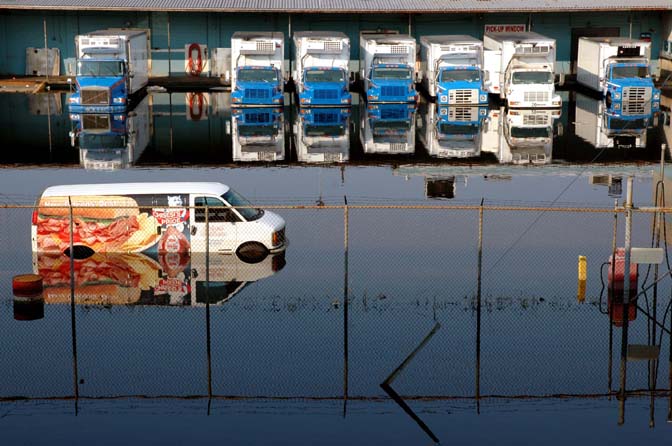
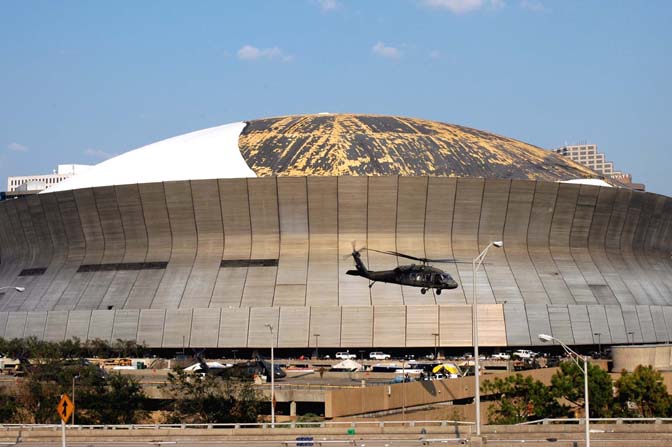

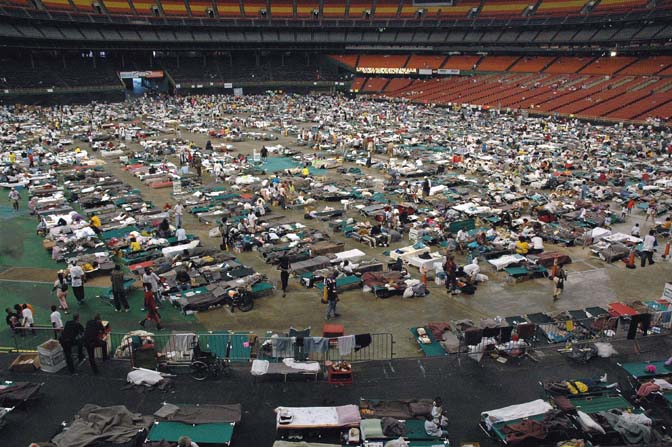
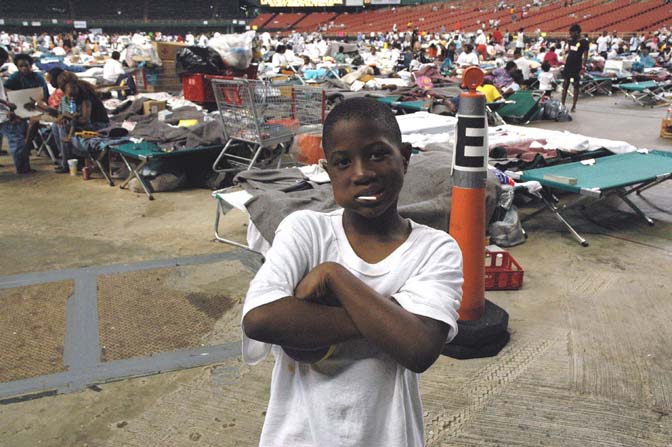
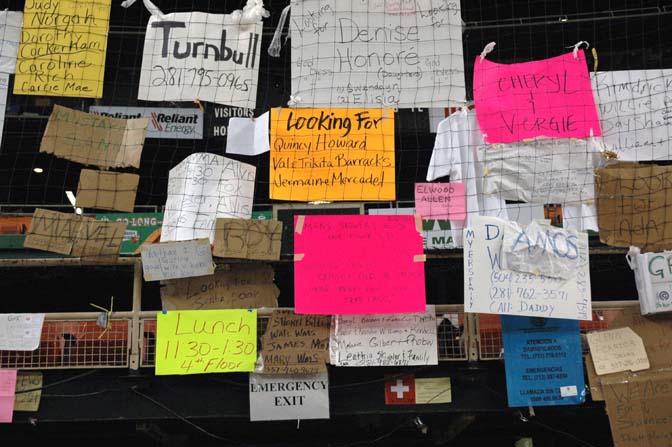
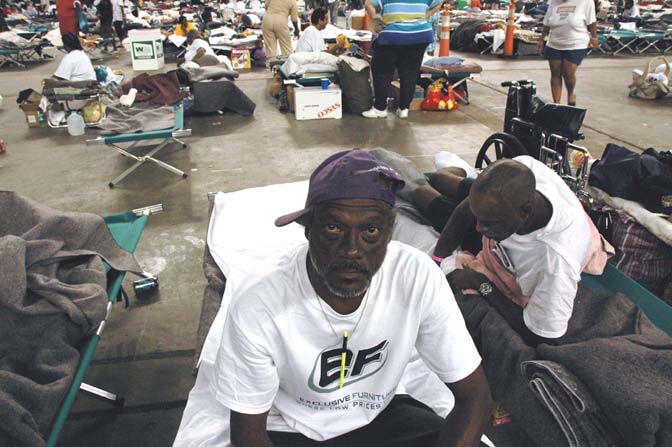
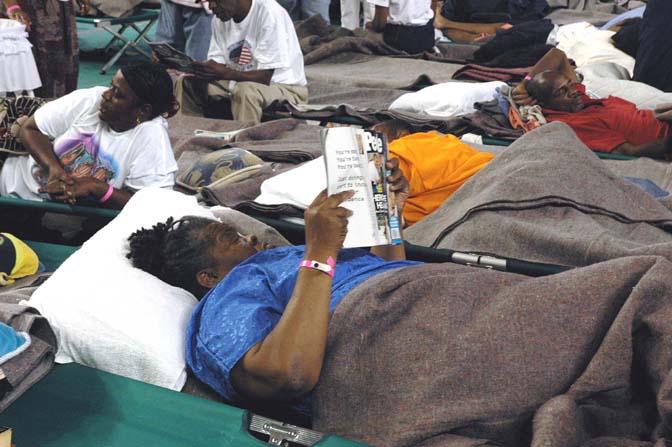
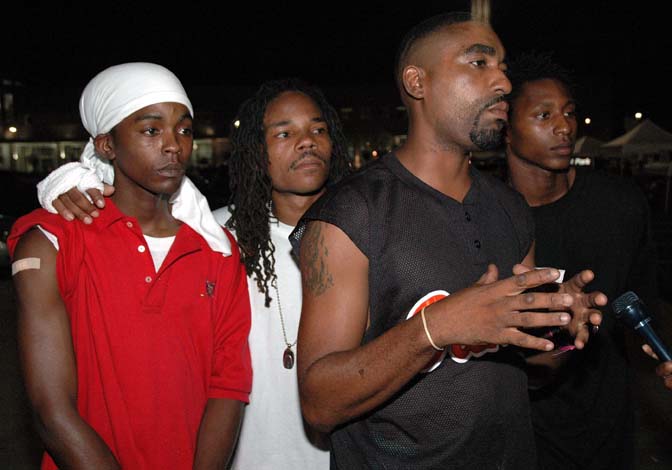
Add Your Comments
Latest Comments
Listed below are the latest comments about this post.
These comments are submitted anonymously by website visitors.
TITLE
AUTHOR
DATE
This photo should be disseminated
Fri, Sep 9, 2005 5:46PM
We are 100% volunteer and depend on your participation to sustain our efforts!
Get Involved
If you'd like to help with maintaining or developing the website, contact us.
Publish
Publish your stories and upcoming events on Indybay.
Topics
More
Search Indybay's Archives
Advanced Search
►
▼
IMC Network


